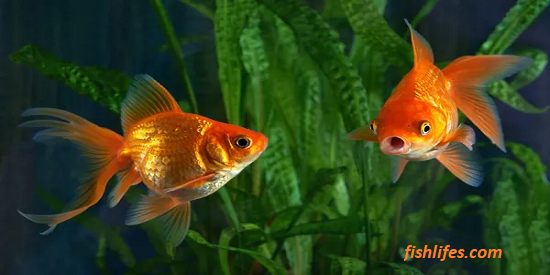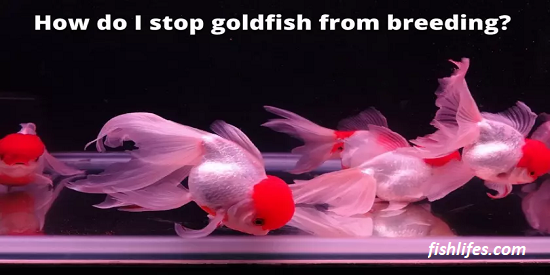Goldfish breeding can be a fun and rewarding hobby, but it can also become a problem if you don’t know how to control it. But how to stop goldfish from breeding? Breeding goldfish in a home aquarium has the potential to become an overpopulation issue quickly. If you’re looking for ways to prevent goldfish from breeding in your tank, this article is for you.
How do Goldfish get Pregnant?
Goldfish are egg layers, meaning they lay hundreds of eggs at once at spawning. After the female lays her eggs, a male will then come along and fertilize them. Usually, this happens in one single mating session. However, occasionally multiple sessions may take place over several days or weeks before all the eggs fertilize.
The process of goldfish getting pregnant is quite interesting! After the eggs have been laid and fertilized by the male, they begin to develop into embryos within three days and hatch approximately seven days later. The fry (baby fish) will stay close to their parents until they reach a particular size and become independent swimmers – usually four to six weeks later.

At What age do Goldfish lay Eggs?
The answer depends on the species of goldfish. Generally, most species of goldfish will be ready to lay eggs by the time they are one year old. However, some varieties, such as shubunkins or comets, may not reach full sexual maturity until they are two years old. It’s also important to remember that a female needs a male partner for spawning; if you have just one fish in your tank, it may never have the chance to reproduce.
What Causes Goldfish to Breed?
Understanding what causes goldfish to breed is key to preventing an overflow of fish in your tank.
For goldfish to breed, they need the right conditions and environment in the tank. Goldfish generally only spawn when water temperatures reach 65-72 degrees Fahrenheit and pH levels stay within the 6-7.5 range. The fish also require a good amount of privacy to feel safe enough to reproduce, so it can be beneficial to add plenty of hiding places like plants or rocks in the aquarium space.
How do you tell if Goldfish are Spawning?
Cues such as physical changes in the fish and behavior can provide insight into whether or not the fish may be preparing to lay eggs.
The first step in determining if goldfish are ready to spawn is observing their physical changes. Male goldfish produce white spots on their gill covers called tubercles, indicating that they’re ready for mating season.
Female goldfish will appear fatter than usual; this means that she’s full of eggs. Additionally, male and female goldfish may also become more colorful during the spawning season – usually exhibiting darker shades of orange or red due to increased levels of hormones.
How often do goldfish reproduce?
Goldfish typically breed during the spring and summer when water temperatures are warmer. This season stimulates their reproductive hormones, spurring male and female goldfish to start breeding. In order to reproduce successfully, both male and female goldfish need to be present in the same tank or body of water. The female will then lay the eggs onto a surface such as vegetation or rocks within the tank, where they will hatch after three days into fry.

What is the Duration of the Goldfish Breeding Season?
The goldfish breeding season typically occurs from spring until late summer. During this time, male goldfish will display vibrant colors as they vie for female attention in the wild.
This signals that mating season has arrived and can last four months, depending on regional temperatures and other environmental conditions. Male goldfish may also become more aggressive during this period due to increased hormone levels caused by the onset of warm weather.
How many Babies do Goldfish have?
Goldfish can lay anywhere from hundreds to thousands of eggs during the breeding season, but the exact number of babies they have depends on various factors.
The size and type of goldfish play a role in determining how many babies they will have. Certain larger varieties may lay up to 10,000 eggs at once, while smaller species may only manage around 100-200 eggs at a time.
How to Stop Goldfish from Breeding?
Breeding goldfish can quickly lead to an overcrowded tank and overly stressed-out fish. But How to stop goldfish from breeding? Luckily, there are some easy steps that you can follow to ensure that your goldfish do not breed.
The first step is understanding the conditions in which your fish would be most likely to reproduce. Goldfish typically require still, warm water, plenty of hiding places, and food to feed on.

By removing any obstacles that may allow for these conditions, such as over-filtration systems or too much vegetation in the tank, you will reduce their chances of spawning by a considerable amount. Changing the water frequently will also help keep breeding at bay as it will ensure the tank’s chemistry does not become favorable for reproduction.
Keep only one gender fish in the aquarium. This is easy to do as male and female goldfish differ in appearance; males typically have more noticeable tubercles on their gill covers, while females may appear fuller due to the eggs they carry.
To ensure that there is only one gender of fish present, it’s best to purchase two or three fish at once so that if too many males or females were added by accident, they can all be returned together.
How to Identify Male and Female Goldfish?
Identifying the gender of a goldfish can be tricky, especially if you’re not an expert. Knowing your fish’s sex is critical for maintaining a healthy tank and deciding how and what to feed them. Here are some tips on identifying male and female goldfish to keep your aquarium running smoothly.
The most obvious way to tell if a goldfish is male or female is by looking at its physical characteristics. Male goldfish generally have more prominent and more intense colors than females while also having longer dorsal fins and small bumps on their gill cover called “breeding tubercles.” Female goldfish typically have shorter fins with rounder bodies that become fuller when they are ready to spawn.
What to do with Baby Fish you Don’t Want?
Are you a hobbyist who has recently been bestowed with baby fish and isn’t sure what to do with them? Caring for baby fish is an enjoyable responsibility, but it’s also a commitment. If you find yourself in this situation, several solutions can help you out.
Sell them away:
The most humane thing is to take the fish to your local pet store. Most stores will be willing to accept your little friends and give them homes in their aquariums.

Give them away:
Several options are available if you’re not prepared for them and don’t want to keep them. The most important thing to consider is the health and safety of the baby fish – they should always go somewhere where they will be properly cared for.
One option is to give away the baby fish to another aquarium enthusiast who can provide adequate care. You can find fellow hobbyists through local aquarium clubs, pet stores, or online forums.
This way, you know that your babies are going somewhere safe and with someone who knows how to take care of them properly. It’s also beneficial for other hobbyists – as having new additions in their tanks can help maintain healthy populations in their home aquariums.
Cull them:
The best thing you can do is cull them—or remove them from the tank—so they don’t overcrowd your tank or put undue stress on the other inhabitants.
Culling baby fish requires careful consideration. You’ll want to remember that removing some of the fries will still leave plenty of prey for the remaining population and help prevent aggression towards each other or other organisms in the tank.
Culling should happen as soon as possible before they grow too large and start competing for resources and space with their parents or siblings.
Do Goldfish eat their Babies?
Yes, indeed, goldfish will sometimes eat their own young. This behavior may be hard to believe, but it is a natural part of the life cycle for these fish. Goldfish are born in large numbers, and they all compete for food. The larger and stronger fish will often consume the smaller ones to control population size and ensure that resources are available for the strongest offspring.
In captive environments, however, this behavior can be minimized by providing plenty of hiding places for small and weak fry within an aquarium or pond. There should also be sufficient food to ensure all offspring have enough to eat without resorting to cannibalism.
Conclusion
How to stop goldfish from breeding? following the steps outlined in this article can help you effectively prevent goldfish from breeding. Remember to keep the fish separate by sex, change the water regularly, and provide suitable plants and decorations in your tank.
Additionally, take into consideration the considerations of the goldfish’s health and well-being when deciding if you should allow them to breed. Taking these precautions can help ensure that your goldfish remain healthy and happy while preventing accidental breeding.
Also, Know About: How to Stop Guppy from Breeding (Easier than you thought)
